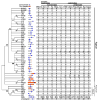Evolutionary change of the numbers of homeobox genes in bilateral animals
- PMID: 16079247
- PMCID: PMC1464090
- DOI: 10.1093/molbev/msi229
Evolutionary change of the numbers of homeobox genes in bilateral animals
Abstract
It has been known that the conservation or diversity of homeobox genes is responsible for the similarity and variability of some of the morphological or physiological characters among different organisms. To gain some insights into the evolutionary pattern of homeobox genes in bilateral animals, we studied the change of the numbers of these genes during the evolution of bilateral animals. We analyzed 2,031 homeodomain sequences compiled from 11 species of bilateral animals ranging from Caenorhabditis elegans to humans. Our phylogenetic analysis using a modified reconciled-tree method suggested that there were at least about 88 homeobox genes in the common ancestor of bilateral animals. About 50-60 genes of them have left at least one descendant gene in each of the 11 species studied, suggesting that about 30-40 genes were lost in a lineage-specific manner. Although similar numbers of ancestral genes have survived in each species, vertebrate lineages gained many more genes by duplication than invertebrate lineages, resulting in more than 200 homeobox genes in vertebrates and about 100 in invertebrates. After these gene duplications, a substantial number of old duplicate genes have also been lost in each lineage. Because many old duplicate genes were lost, it is likely that lost genes had already been differentiated from other groups of genes at the time of gene loss. We conclude that both gain and loss of homeobox genes were important for the evolutionary change of phenotypic characters in bilateral animals.
Figures




Similar articles
-
Evolutionary history of the iroquois/Irx genes in metazoans.BMC Evol Biol. 2009 Apr 15;9:74. doi: 10.1186/1471-2148-9-74. BMC Evol Biol. 2009. PMID: 19368711 Free PMC article.
-
Comparative genomics of ParaHox clusters of teleost fishes: gene cluster breakup and the retention of gene sets following whole genome duplications.BMC Genomics. 2007 Sep 6;8:312. doi: 10.1186/1471-2164-8-312. BMC Genomics. 2007. PMID: 17822543 Free PMC article.
-
Whole genome duplications and expansion of the vertebrate GATA transcription factor gene family.BMC Evol Biol. 2009 Aug 20;9:207. doi: 10.1186/1471-2148-9-207. BMC Evol Biol. 2009. PMID: 19695090 Free PMC article.
-
Vertebrate genomics: More fishy tales about Hox genes.Curr Biol. 1999 Mar 25;9(6):R210-3. doi: 10.1016/s0960-9822(99)80131-6. Curr Biol. 1999. PMID: 10209088 Review.
-
Gene duplication: past, present and future.Semin Cell Dev Biol. 1999 Oct;10(5):541-7. doi: 10.1006/scdb.1999.0335. Semin Cell Dev Biol. 1999. PMID: 10597638 Review.
Cited by
-
Characterization of Rice Homeobox Genes, OsHOX22 and OsHOX24, and Over-expression of OsHOX24 in Transgenic Arabidopsis Suggest Their Role in Abiotic Stress Response.Front Plant Sci. 2016 May 10;7:627. doi: 10.3389/fpls.2016.00627. eCollection 2016. Front Plant Sci. 2016. PMID: 27242831 Free PMC article.
-
Selectionism and neutralism in molecular evolution.Mol Biol Evol. 2005 Dec;22(12):2318-42. doi: 10.1093/molbev/msi242. Epub 2005 Aug 24. Mol Biol Evol. 2005. PMID: 16120807 Free PMC article.
-
Phylogenetic and transcriptomic analysis of chemosensory receptors in a pair of divergent ant species reveals sex-specific signatures of odor coding.PLoS Genet. 2012;8(8):e1002930. doi: 10.1371/journal.pgen.1002930. Epub 2012 Aug 30. PLoS Genet. 2012. PMID: 22952454 Free PMC article.
-
Reconciliation with non-binary species trees.J Comput Biol. 2008 Oct;15(8):981-1006. doi: 10.1089/cmb.2008.0092. J Comput Biol. 2008. PMID: 18808330 Free PMC article.
-
Zinc Finger-Homeodomain Transcriptional Factors (ZHDs) in Upland Cotton (Gossypium hirsutum): Genome-Wide Identification and Expression Analysis in Fiber Development.Front Genet. 2018 Oct 9;9:357. doi: 10.3389/fgene.2018.00357. eCollection 2018. Front Genet. 2018. PMID: 30356782 Free PMC article.
References
-
- Aguinaldo AM, Turbeville JM, Linford LS, Rivera MC, Garey JR, Raff RA, Lake JA. Evidence for a clade of nematodes, arthropods and other moulting animals. Nature. 1997;387:489–493. - PubMed
-
- Aparicio S, Hawker K, Cottage A, Mikawa Y, Zuo L, Venkatesh B, Chen E, Krumlauf R, Brenner S. Organization of the Fugu rubripes Hox clusters: evidence for continuing evolution of vertebrate Hox complexes. Nat Genet. 1997;16:79–83. - PubMed
Publication types
MeSH terms
Grants and funding
LinkOut - more resources
Full Text Sources
Research Materials

